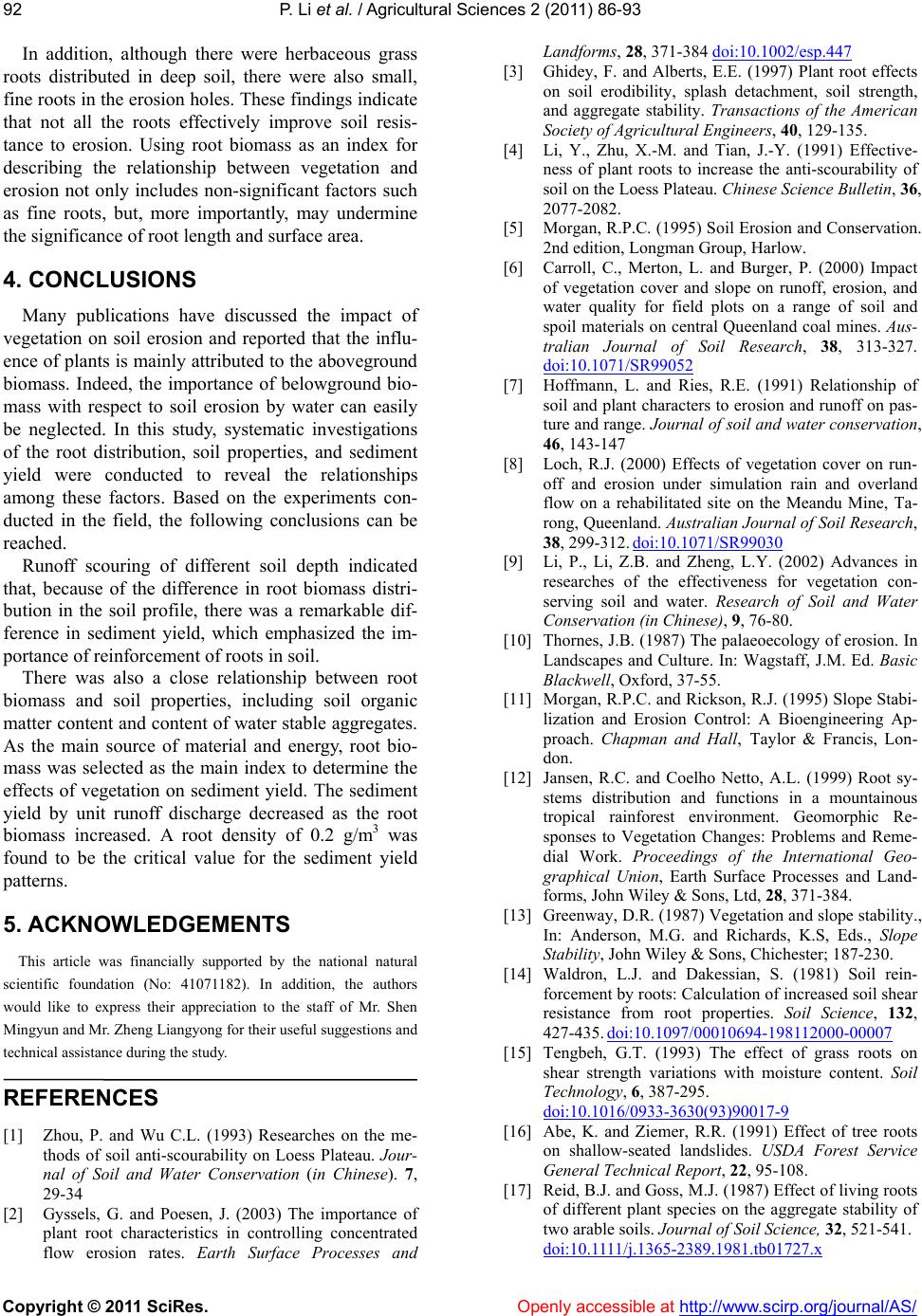
P. Li et al. / Agricultur al Sciences 2 (2011) 86-93
Copyright © 2011 SciRes. Openly accessible at http://www.scirp.org/journal/AS/
92
In addition, although there were herbaceous grass
roots distributed in deep soil, there were also small,
fine roots in the erosion holes. These findings indicate
that not all the roots effectively improve soil resis-
tance to erosion. Using root biomass as an index for
describing the relationship between vegetation and
erosion not only includes non-significant factors such
as fine roots, but, more importantly, may undermine
the significance of root length and surface area.
4. CONCLUSIONS
Many publications have discussed the impact of
vegetation on soil erosion and reported that the influ-
ence of plants is mainly attributed to the aboveground
biomass. Indeed, the importance of belowground bio-
mass with respect to soil erosion by water can easily
be neglected. In this study, systematic investigations
of the root distribution, soil properties, and sediment
yield were conducted to reveal the relationships
among these factors. Based on the experiments con-
ducted in the field, the following conclusions can be
reached.
Runoff scouring of different soil depth indicated
that, because of the difference in root biomass distri-
bution in the soil profile, there was a remarkable dif-
ference in sediment yield, which emphasized the im-
portance of reinforcement of roots in soil.
There was also a close relationship between root
biomass and soil properties, including soil organic
matter content and content of water stable aggregates.
As the main source of material and energy, root bio-
mass was selected as the main index to determine the
effects of vegetation on sediment yield. The sediment
yield by unit runoff discharge decreased as the root
biomass increased. A root density of 0.2 g/m3 was
found to be the critical value for the sediment yield
patterns.
5. ACKNOWLEDGEMENTS
This article was financially supported by the national natural
scientific foundation (No: 41071182). In addition, the authors
would like to express their appreciation to the staff of Mr. Shen
Mingyun and Mr. Zheng Liangyong for their useful suggestions and
technical assistance during the study.
REFERENCES
[1] Zhou, P. and Wu C.L. (1993) Researches on the me-
thods of soil anti-scourability on Loess Plateau. Jour-
nal of Soil and Water Conservation (in Chinese). 7,
29-34
[2] Gyssels, G. and Poesen, J. (2003) The importance of
plant root characteristics in controlling concentrated
flow erosion rates. Earth Surface Processes and
Landforms, 28, 371-384 doi:10.1002/esp.447
[3] Ghidey, F. and Alberts, E.E. (1997) Plant root effects
on soil erodibility, splash detachment, soil strength,
and aggregate stability. Transactions of the American
Society of Agricultural Engineers, 40, 129-135.
[4] Li, Y., Zhu, X.-M. and Tian, J.-Y. (1991) Effective-
ness of plant roots to increase the anti-scourability of
soil on the Loess Plateau. Chinese Science Bulletin, 36,
2077-2082.
[5] Morgan, R.P.C. (1995) Soil Erosion and Conservation.
2nd edition, Longman Group, Harlow.
[6] Carroll, C., Merton, L. and Burger, P. (2000) Impact
of vegetation cover and slope on runoff, erosion, and
water quality for field plots on a range of soil and
spoil materials on central Queenland coal mines. Aus-
tralian Journal of Soil Research, 38, 313-327.
doi:10.1071/SR99052
[7] Hoffmann, L. and Ries, R.E. (1991) Relationship of
soil and plant characters to erosion and runoff on pas-
ture and range. Journal of soil and water conservation,
46, 143-147
[8] Loch, R.J. (2000) Effects of vegetation cover on run-
off and erosion under simulation rain and overland
flow on a rehabilitated site on the Meandu Mine, Ta-
rong, Queenland. Australian Journal of Soil Research,
38, 299-312. doi:10.1071/SR99030
[9] Li, P., Li, Z.B. and Zheng, L.Y. (2002) Advances in
researches of the effectiveness for vegetation con-
serving soil and water. Research of Soil and Water
Conservation (in Chinese), 9, 76-80.
[10] Thornes, J.B. (1987) The palaeoecology of erosion. In
Landscapes and Culture. In: Wagstaff, J.M. Ed. Basic
Blackwell, Oxford, 37-55.
[11] Morgan, R.P.C. and Rickson, R.J. (1995) Slope Stabi-
lization and Erosion Control: A Bioengineering Ap-
proach. Chapman and Hall, Taylor & Francis, Lon-
don.
[12] Jansen, R.C. and Coelho Netto, A.L. (1999) Root sy-
stems distribution and functions in a mountainous
tropical rainforest environment. Geomorphic Re-
sponses to Vegetation Changes: Problems and Reme-
dial Work. Proceedings of the International Geo-
graphical Union, Earth Surface Processes and Land-
forms, John Wiley & Sons, Ltd, 28, 371-384.
[13] Greenway, D.R. (1987) Vegetation and slope stability.,
In: Anderson, M.G. and Richards, K.S, Eds., Slope
Stability, John Wiley & Sons, Chichester; 187-230.
[14] Waldron, L.J. and Dakessian, S. (1981) Soil rein-
forcement by roots: Calculation of increased soil shear
resistance from root properties. Soil Science, 132,
427-435. doi:10.1097/00010694-198112000-00007
[15] Tengbeh, G.T. (1993) The effect of grass roots on
shear strength variations with moisture content. Soil
Technology, 6, 387-295.
doi:10.1016/0933-3630(93)90017-9
[16] Abe, K. and Ziemer, R.R. (1991) Effect of tree roots
on shallow-seated landslides. USDA Forest Service
General Technical Report, 22, 95-108.
[17] Reid, B.J. and Goss, M.J. (1987) Effect of living roots
of different plant species on the aggregate stability of
two arable soils. Journal of Soil Science, 32, 521-541.
doi:10.1111/j.1365-2389.1981.tb01727.x